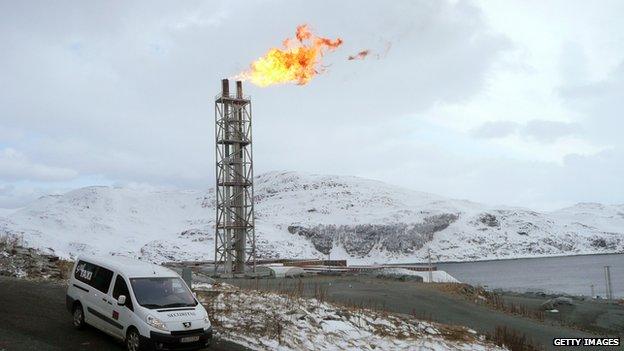Russia's Arctic: Mission to protect wildlife
- Published
Scientists warn that the Laptev Sea is home to important and possibly rare species
Russia is planning huge oil and gas developments in the Arctic Ocean off its northern coast - drilling that could threaten pristine wildlife habitats.
Large-scale production could begin in the next two decades, if the price of oil rises high enough.
Preliminary exploration has already begun, including in the Laptev Sea.
But scientists say the region is home to important, thriving populations of walrus and polar bears, which could be put at risk.
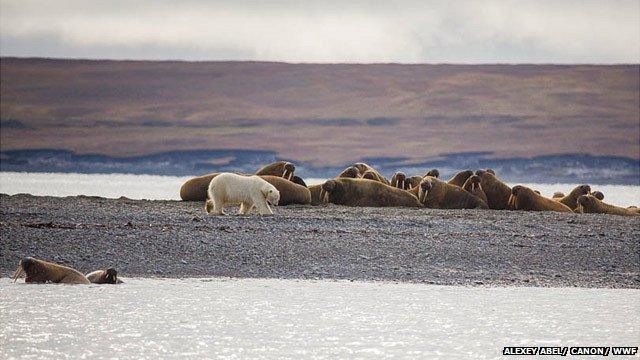
The early retreat of ice makes life harder for the polar bear and walrus
Biologists on the 2013 Laptev Expedition this summer have been trying to establish if the walruses and polar bears there are a unique group, in need of special protection. BBC journalists went with them to investigate the issue.
We flew to Khatanga, one of the most northerly towns in Siberia, and there we boarded a small boat, the Taimyr.
From Khatanga it was a two-day, 500km (310-mile) journey almost due north.
Polar bears
After the first day it became clear we had entered the domain of the polar bear. First we saw a mother with two five-month-old cubs on Maliy Begichev Island.
Then we saw a big "haul-out" of walrus at Cape Tsvetkov - perhaps 400-600 there, resting on the beach. Towering above them on the last large lump of ice was a large polar bear.
But our destination was Maria Pronchishcheva Bay, half-way up the Taimyr Peninsula. It is the most northerly bit of land in the world still attached to a continent.
"The oil companies are coming here with exploration projects already, and there are ongoing seismic explorations," said Igor Chestin, chief executive of the environmental group WWF Russia.
"So before the real oil and gas projects develop in the area we need to know that there is sufficient knowledge of the conservation needs here, which would allow us to put in the necessary protection if this development ever happens."
From satellite photographs taken a week earlier, the scientists on the expedition knew there had also been a large walrus "haul-out" there previously. By the time we sailed into the bay the number had dropped to around 60. But it was still enough for the crucial scientific work of the expedition - collecting DNA from the Laptev walrus.
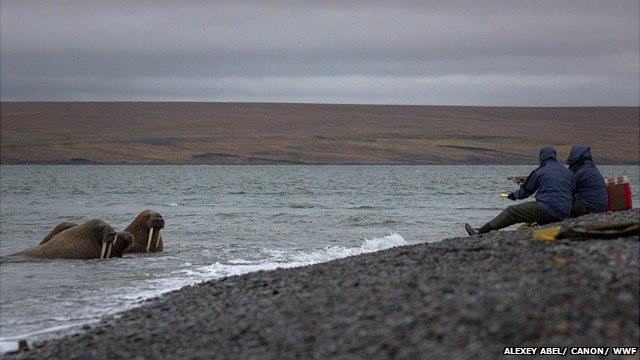
Researchers want to find out more about the Laptev walrus
Collecting samples
Walrus expert Anatoly Kochnev of ChukotTINRO, a marine biology group, was despatched to the pebbly spit where the animals were resting.
We watched as he fired crossbow darts into the sides of the walrus, which he then retrieved with a thin piece of line attached to each dart. At the head of each dart was a biopsy punch, which pulled out a piece of walrus skin and fat as it was retrieved.
The samples will be sent to labs in Moscow and Denmark for DNA analysis. The plan is to end a long scientific dispute over whether the Laptev walrus is a unique sub-species in need of special protection, genetically different from the Pacific walrus and the Atlantic walrus.
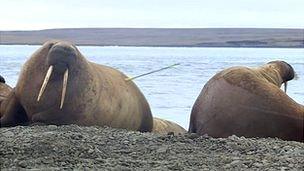
Darts are used to collect vital samples from the walrus
Just one hour after Anatoly Kochnev's third trip out to the spit, a huge male polar bear appeared in the exact spot where he had been kneeling to fire the crossbow. The bear tried to kill one of the walrus, but was unsuccessful - this time.
Polar bear expert Geoff York of WWF's Global Arctic Programme is collecting samples - faeces and hair - which will also be sent for DNA analysis. Again there is a concern that the polar bears of the Laptev Sea may be unique and in need of special protection.
"If that is true then in most countries you would need to identify the habitat being used by bears," Geoff York said.
"Are they making dens onshore? How are they using the land in summer? Then you would protect those habitats at least in the relevant seasons. If you do indeed have two unique sub-populations of marine mammals here you might consider that this should be a Marine Protected Area, and you might exclude any industrial development."
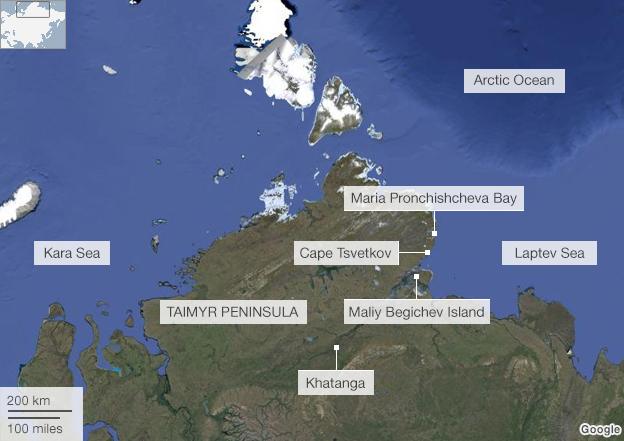
Ice retreating
The concern about the large marine mammals of the Laptev Sea has increased in the last decade for two reasons.
Firstly, climate change has led to a dramatic shrinking of the Arctic ice cap in recent summers. This has meant that in order to stay close to their feeding grounds the walruses have had to come ashore in much larger numbers, instead of staying on the ice where they feel more comfortable.
Polar bears are also being forced ashore, where they find it much harder to feed. Their preferred meal, the ringed seal, is not available onshore and they often are reduced to going after the much more dangerous walrus.
Secondly, there are plans to develop the Laptev Sea for oil and gas production. The water here is shallow, which makes it easier to drill, and there are believed to be large deposits of hydrocarbons. This exploration work may frighten the nervous bear and walruses, and could disrupt their food supply.
Conservationists think the arrival of much greater numbers of humans could also increase hunting, further disrupting the delicate balance of nature here. They say that nobody has yet worked out how to control an oil spill in seas that are close to freezing.

The Laptev Sea is now a target for large-scale energy exploration
The Russian government says the country's future wealth depends on exploiting the deposits here and in other parts of the Arctic. The deposits will not be easy to extract, but they are almost certainly there.
"Most of the estimates give more than 20% of global undiscovered oil deposits to Russian Arctic seas," said Alexev Piskarev, author of Energy Potential of the Russian Arctic Seas.
Shipping route
The melting sea ice has also opened up new shipping routes. Russia is now advertising the Northern Sea Route, which cuts the journey time from China to Europe by up to two weeks.
"You save time and you save fuel. It is much more economical," said Alexander Olshevsky, head of the Northern Sea Route Administration. "Though you will need to pay for a nuclear-powered icebreaker, and of course you will need a boat that can deal with these conditions."
But again, opening up the Northern Sea Route could disrupt the fragile ecosystem. More than 400 ships will make the journey this year - yet in 2010 it was only four.
On our brief, two-week trip we have seen extraordinary fire-red Arctic skies, gleaming snowy owls and grumpy musk ox, and an almost untouched landscape of thin yellow tundra covering the permafrost. The temperature has barely risen above 10C and has often been closer to freezing.
It is one of the last wildernesses of the world, a place few people even know exists, but modern industry is already starting to encroach on it.
(BBC Moscow correspondent Daniel Sandford went on the 2013 Laptev Expedition with BBC cameraman Anton Chicherov and producer Emma Wells.)
- Published25 March 2024
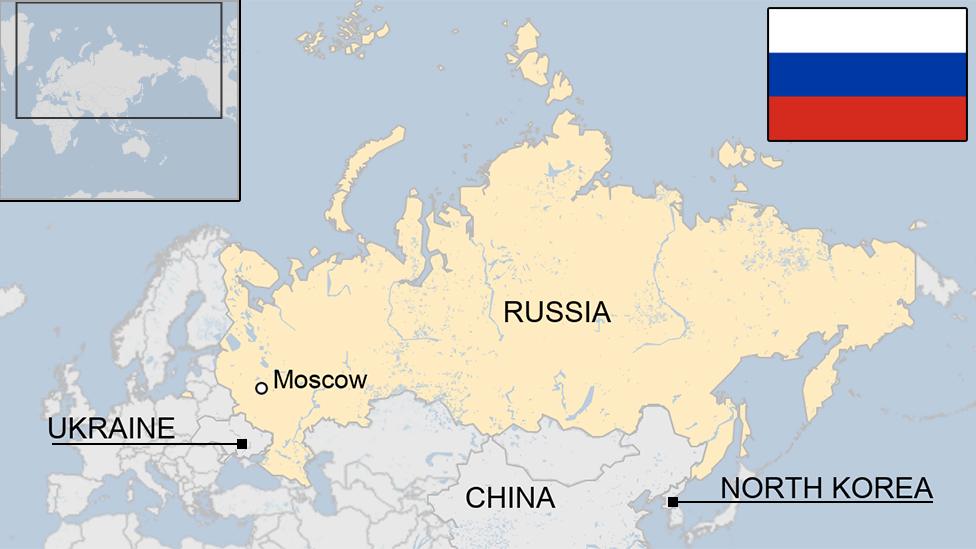
- Published4 February 2013
